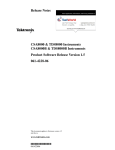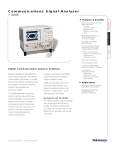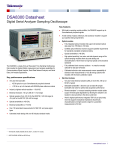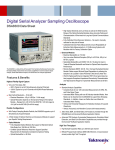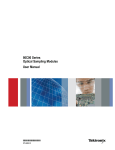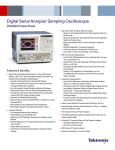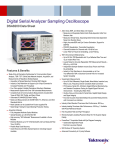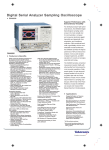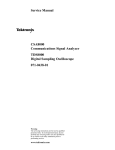Download 80E02 User Manual
Transcript
xx ZZZ 80C00 and 80E00 Series Optical and Electrical Sampling Modules User Manual *P071305902* 071-3059-02 xx ZZZ 80C00 and 80E00 Series Optical and Electrical Sampling Modules User Manual www.tektronix.com 071-3059-02 Copyright © Tektronix. All rights reserved. Licensed software products are owned by Tektronix or its subsidiaries or suppliers, and are protected by national copyright laws and international treaty provisions. Tektronix products are covered by U.S. and foreign patents, issued and pending. Information in this publication supersedes that in all previously published material. Specifications and price change privileges reserved. TEKTRONIX and TEK are registered trademarks of Tektronix, Inc. Contacting Tektronix Tektronix, Inc. 14150 SW Karl Braun Drive P.O. Box 500 Beaverton, OR 97077 USA For product information, sales, service, and technical support: In North America, call 1-800-833-9200. Worldwide, visit www.tektronix.com to find contacts in your area. Warranty Tektronix warrants that this product will be free from defects in materials and workmanship for a period of one (1) year from the date of shipment. If any such product proves defective during this warranty period, Tektronix, at its option, either will repair the defective product without charge for parts and labor, or will provide a replacement in exchange for the defective product. Parts, modules and replacement products used by Tektronix for warranty work may be new or reconditioned to like new performance. All replaced parts, modules and products become the property of Tektronix. In order to obtain service under this warranty, Customer must notify Tektronix of the defect before the expiration of the warranty period and make suitable arrangements for the performance of service. Customer shall be responsible for packaging and shipping the defective product to the service center designated by Tektronix, with shipping charges prepaid. Tektronix shall pay for the return of the product to Customer if the shipment is to a location within the country in which the Tektronix service center is located. Customer shall be responsible for paying all shipping charges, duties, taxes, and any other charges for products returned to any other locations. This warranty shall not apply to any defect, failure or damage caused by improper use or improper or inadequate maintenance and care. Tektronix shall not be obligated to furnish service under this warranty a) to repair damage resulting from attempts by personnel other than Tektronix representatives to install, repair or service the product; b) to repair damage resulting from improper use or connection to incompatible equipment; c) to repair any damage or malfunction caused by the use of non-Tektronix supplies; or d) to service a product that has been modified or integrated with other products when the effect of such modification or integration increases the time or difficulty of servicing the product. THIS WARRANTY IS GIVEN BY TEKTRONIX WITH RESPECT TO THE PRODUCT IN LIEU OF ANY OTHER WARRANTIES, EXPRESS OR IMPLIED. TEKTRONIX AND ITS VENDORS DISCLAIM ANY IMPLIED WARRANTIES OF MERCHANTABILITY OR FITNESS FOR A PARTICULAR PURPOSE. TEKTRONIX' RESPONSIBILITY TO REPAIR OR REPLACE DEFECTIVE PRODUCTS IS THE SOLE AND EXCLUSIVE REMEDY PROVIDED TO THE CUSTOMER FOR BREACH OF THIS WARRANTY. TEKTRONIX AND ITS VENDORS WILL NOT BE LIABLE FOR ANY INDIRECT, SPECIAL, INCIDENTAL, OR CONSEQUENTIAL DAMAGES IRRESPECTIVE OF WHETHER TEKTRONIX OR THE VENDOR HAS ADVANCE NOTICE OF THE POSSIBILITY OF SUCH DAMAGES. [W2 – 15AUG04] Table of Contents Compliance information . . . . . . . . . . . . . . . . . . . . . . . . . . . . . . . . . . . . . . . . . . . . . . . . General safety summary . . . . . . . . . . . . . . . . . . . . . . . . . . . . . . . . . . . . . . . . . . . EMC compliance . . . . . . . . . . . . . . . . . . . . . . . . . . . . . . . . . . . . . . . . . . . . . . . . . . . Environmental considerations . . . . . . . . . . . . . . . . . . . . . . . . . . . . . . . . . . . . . Preface. . . . . . . . . . . . . . . . . . . . . . . . . . . . . . . . . . . . . . . . . . . . . . . . . . . . . . . . . . . . . . . . . . . . . Related documents . . . . . . . . . . . . . . . . . . . . . . . . . . . . . . . . . . . . . . . . . . . . . . . . . . Getting started . . . . . . . . . . . . . . . . . . . . . . . . . . . . . . . . . . . . . . . . . . . . . . . . . . . . . . . . . . . . How to handle modules to prevent electrostatic damage . . . . . . . . Module, instrument, and software compatibility . . . . . . . . . . . . . . . . . Typical module configurations . . . . . . . . . . . . . . . . . . . . . . . . . . . . . . . . . . . . . Install or remove a module . . . . . . . . . . . . . . . . . . . . . . . . . . . . . . . . . . . . . . . . . Verify module install . . . . . . . . . . . . . . . . . . . . . . . . . . . . . . . . . . . . . . . . . . . . . . . . Operating basics . . . . . . . . . . . . . . . . . . . . . . . . . . . . . . . . . . . . . . . . . . . . . . . . . . . . . . . . . . Using the module to take measurements . . . . . . . . . . . . . . . . . . . . . . . . . . Module controls and indicators . . . . . . . . . . . . . . . . . . . . . . . . . . . . . . . . . . . . Connecting optical signals. . . . . . . . . . . . . . . . . . . . . . . . . . . . . . . . . . . . . . . . . . Connecting electrical signals . . . . . . . . . . . . . . . . . . . . . . . . . . . . . . . . . . . . . Remote module mounting . . . . . . . . . . . . . . . . . . . . . . . . . . . . . . . . . . . . . . . . Cleaning the module . . . . . . . . . . . . . . . . . . . . . . . . . . . . . . . . . . . . . . . . . . . . . . . . . . . Cleaning optical connectors . . . . . . . . . . . . . . . . . . . . . . . . . . . . . . . . . . . . . . . . . . . Appendix A: Module, instrument, and software compatibility . . . . . DSA8300 instrument software and module compatibility . . . . . Legacy instrument software and module compatibility . . . . . . . . Appendix B: Accessories and options . . . . . . . . . . . . . . . . . . . . . . . . . . . . . . . . Appendix C: Electrical connector torque settings . . . . . . . . . . . . . . . . . . . Index 80C00, 80E00 Sampling Modules User Manual ii ii ii iii v v 1 1 2 2 3 4 7 7 7 8 10 10 13 14 17 17 18 21 25 i Compliance information Compliance information General safety summary As the modules covered in the manual are for use only when installed in the main instrument, see the primary instrument user documentation for general safety summary information. Ground the product. This product is indirectly grounded through the grounding conductor of the mainframe power cord. To avoid electric shock, the grounding conductor must be connected to earth ground. Before making connections to the input or output terminals of the product, ensure that the product is properly grounded. EMC compliance As the modules covered in the manual are for use only when installed in the main instrument, see the primary instrument user documentation for EMC compliance information. ii 80C00, 80E00 Sampling Modules User Manual Compliance information Environmental considerations This section provides information about the environmental impact of the product. Product end-of-life handling Observe the following guidelines when recycling an instrument or component: Equipment recycling. Production of this equipment required the extraction and use of natural resources. The equipment may contain substances that could be harmful to the environment or human health if improperly handled at the product’s end of life. To avoid release of such substances into the environment and to reduce the use of natural resources, we encourage you to recycle this product in an appropriate system that will ensure that most of the materials are reused or recycled appropriately. This symbol indicates that this product complies with the applicable European Union requirements according to Directives 2002/96/EC and 2006/66/EC on waste electrical and electronic equipment (WEEE) and batteries. For information about recycling options, check the Support/Service section of the Tektronix Web site (www.tektronix.com). Restriction of hazardous substances This product is classified as an industrial monitoring and control instrument, and is not required to comply with the substance restrictions of the recast RoHS Directive 2011/65/EU until July 22, 2017. 80C00, 80E00 Sampling Modules User Manual iii Compliance information iv 80C00, 80E00 Sampling Modules User Manual Preface This document describes how to install and verify operation of an optical (80C00 series) or electrical (80E00 series) sampling module for use in the DSA8300 Digital Serial Analyzer and supported legacy instruments. Legacy instruments include the TDS/CSA/DSA8200, TDS/CSA8000B, and TDS/CSA8000 series instruments. Related documents This module is a part of a larger instrument system. Measurement-related settings, such as signal acquisition, standards selection, filters, vertical scaling, and horizontal sampling rate, are set from the main instrument Setup controls. The parameters available depend on the modules installed in the instrument. See the instrument online help and documentation for information on setting up and taking measurements, instrument specifications, programming commands, and performance verification procedures. You can download the latest version of these documents from the Tektronix Web site (www.tek.com/downloads). DSA8300 Digital Serial Analyzer Quick Start User Manual DSA8300 Programmer Manual DSA8300 Specification Technical Reference DSA8300 Service Technical Reference DSA8300 Performance Verification Technical Reference For legacy instruments (TDS/CSA/DSA8200, TDS/CSA8000B, and TDS/CSA8000), go to www.tek.com/downloads and search for the manual for your instrument. 80C00, 80E00 Sampling Modules User Manual v Preface vi 80C00, 80E00 Sampling Modules User Manual Getting started How to handle modules to prevent electrostatic damage CAUTION. Electrostatic discharge (ESD) can damage sampling module electrical inputs and outputs. Observe the following guidelines to prevent ESD: Always use a grounded wrist strap (provided with your instrument) when installing or removing modules from the mainframe and when connecting cables. Wear anti-static clothing and work in a static-free are when using sampling modules. Discharge cables to ground before connecting them to modules. Do not create an ESD antenna by leaving cables attached to the sampling-module input with the other end of the cable open. Use a Tektronix 80A02 EOS/ESD Protection Module if doing TDR work. Always store and transport modules in a static-free container, with all supplied terminations installed. Do not transport or ship the instrument with the modules installed in the module compartments. 80C00, 80E00 Sampling Modules User Manual 1 Getting started Module, instrument, and software compatibility See Appendix A for information on instrument TekScope application and operating system requirements for specific modules. (See page 17.) Typical module configurations Eight channels: No large and four small modules. Seven channels: One large module, installed in CH3 compartment, and three small modules. Seven channels: One large module, installed in CH1 compartment, and three small modules. Six channels: Two large modules and two small modules. 2 80C00, 80E00 Sampling Modules User Manual Getting started Install or remove a module 1. Connect an antistatic wrist strap to the instrument front-panel ground connection. Place the strap on your wrist. 2. For optical modules, turn the module lock screws counterclockwise to rotate the retaining tabs to a vertical position before inserting the module. 3. Use the power cycle that is appropriate for your instrument: DSA8300 instruments with TekScope application version 6.1.X and greater: Click Tools > View/Change Module Config and follow the on-screen instructions. Legacy instruments and DSA8300 with TekScope application version 6.0.X: Power off the instrument using the front-panel On/Standby switch. 4. Push the module into a compartment, using firm pressure. When the module is seated, turn the lock screw(s) clockwise to tighten the module in the slot. 5. Power on the instrument (legacy instruments or DSA8300 with TekScope 6.0.X software) or complete the View/Change Module Config process (TekScope version 6.1.X and later). Let the instrument warm up for 20 minutes. NOTE. The warm-up cycle is not required if you installed the module using the View/Change Module Config function (TekScope version 6.1.X and later). 6. In the TekScope application, click Utilities > Compensate and run a compensation on the newly-installed module. You must also run a compensation if a module is moved from one slot to another, or an extender is installed, changed, or removed from a module. 7. Use the Differential Channel Alignment application (Applications > DiffChAlign) to align both channels (and TDR steps when applicable) of supported two-channel electrical modules, to the module input connectors. This application steps through the connection setup to align both the acquisition and the TDR steps. For more information, see the help file for the application. 80C00, 80E00 Sampling Modules User Manual 3 Getting started The Differential Channel Alignment application is available for DSA8300 instruments running TekScope firmware version 6.2.X and later, and legacy instruments running TekScope version 5.2.x and later. 8. To remove a module: Power off the instrument (or run the View/Change Module Config tool in instruments with TekScope version 6.1.X and later, and follow instructions). Wear an anti-static strap. Turn lock screw(s) counterclockwise until loose or they stop turning. Push the appropriate ejector lever (as indicated by the up or down arrow near each lever) to the right to disconnect the module, then pull the module out of the slot. Verify module install 4 1. In the TekScope application, click Utilities > System Properties. 2. Click the Modules tab. 3. Click the + next to the channel(s) of the newly-installed module. 4. Verify that the screen lists the correct module number. 80C00, 80E00 Sampling Modules User Manual Getting started Run module compensation to optimize measurement accuracy: 1. Click Utilities > Compensation. Verify that the installed module is listed in the Upper Modules or Lower Modules field, as appropriate for the module. 2. Click the Mainframe button (center-right side of dialog box) and select Module. 3. Click the Channel button and select the channel appropriate for the installed module. 4. Click Execute. The instrument runs the module compensation routine and updates the list with the results. 5. For two channel modules, repeat steps 3 and 4 for the second channel. 80C00, 80E00 Sampling Modules User Manual 5 Getting started 6 80C00, 80E00 Sampling Modules User Manual Operating basics Using the module to take measurements This module is a part of a larger instrument system. Sampling module settings, such as bandwidth or signal standard, vertical scaling, and horizontal sampling rate, are set from the main instrument controls. The parameters available depend on the modules installed in the instrument. See the instrument documentation for information on taking measurements. Module controls and indicators The SELECT ON/OF button turns on or off a channel. On two-channel modules, this button also selects the active channel when both are enabled. The channel LED is on when a channel is active (acquiring a signal) or enabled (available but not acquiring). The LED is OFF when that channel is inactive (turned off). The TDR indicator LED (on supported electrical modules) indicates when that channel is enabled for TDR measurements. The main instrument turns this LED on or off. The TekProbe connector (on supported electrical modules) provides power and control to attached remote accessories that require TekProbe SMA support at levels 1 and 2. 80C00, 80E00 Sampling Modules User Manual 7 Operating basics Connecting optical signals CAUTION. To prevent loss of optical power or damage to the optical connectors, keep the connectors clean at all times. Check that all connectors, jumpers, and protective caps are clean before connecting them to the module. Do not drop an optical module, as doing so can cause damage and misalignment of the photodiode optical assembly. Optical modules use a universal connector interface (UCI) that allows use of many standard fiber-optic female connector styles. Some of the standard UCI interfaces supported are FC, ST, SC, and DIN. Attach the fiber optic cable with a suitable connector or a UCI Interface adapter to the optical input receptacle as follows: 1. Line up the key with the slot in the UCI adapter before inserting. 2. Firmly press the cable connector or adapter into the UIC interface ferrule until it reaches the stop. CAUTION. Do not insert the connector into the UCI adapter at an angle. Do not insert the connector and then rotate to line up the key with the slot. Either action may damage the UCI adapter. 8 4. Firmly tighten the cable connector or the adapter shell. Tighten with finger pressure only. 5. To remove, loosen the cable connector or adapter shell. 80C00, 80E00 Sampling Modules User Manual Operating basics Optical signal guidelines CAUTION. To avoid damaging the module optical input, maintain signal levels within optimal performance range, and avoid clipping, attenuate the input optical signal to the Absolute Maximum Nondestructive Optical Input (peak) specifications. (See Table 1.) Table 1: Maximum optical signal levels Module Average Peak 80C02, 80C07B/C, 80C11/B 5 mW 10 mW 80C08C/D, 80C12/B 1 mW 10 mW 80C10B/C, 80C25GBE 20 mW 60 mW 80C15 5 mW (1310/1550 nm) 3 mW (850 nm) 10 mW (1310/1550 nm) 6 mW (850 nm) The 80C07B module can have a somewhat deteriorated response for signals greater than 200 μWp-p (1310 nm and 1550 nm) and 400 mWp-p (780 nm and 850 nm). The 80C08C and 80C12 modules can have a somewhat deteriorated response for signals larger than 500 μWp-p (1310 nm and 1550 nm) and 800 mWp-p (850 nm). Optical sampling modules may have dynamic ranges exceeded without obvious visual indication on the display because the overloaded photodetector signal output may still be within the dynamic range of the internal electrical sampler. 80C00, 80E00 Sampling Modules User Manual 9 Operating basics Connecting electrical signals CAUTION. Electrostatic discharge (ESD) will cause permanent damage to electrical inputs and outputs. Adhere to standard ESD handling precautions when attaching cables to electrical input and output connectors. Always use a safely-grounded wrist strap (provided with your instrument) when installing modules in the mainframe, handling modules, or making connections. Make sure to discharge all electrical signal cables or connectors to ground before attaching them to the module. To discharge a cable, touch the center pin of the coaxial cable to a grounded conductor (such as the outside ground conductor of an electrical connector) just before connecting the cable to the module. Tighten and loosen electrical SMA connectors using the correct size torque wrench, set to 56 N-cm (5 in-lb), or the torque setting valid for the connection type. (See page 25, Electrical connector torque settings.) NOTE. Use 50 Ω SMA terminations, provided with the module, on all unused electrical connectors. Remote module mounting Remote electrical modules have both guide rails and end plate mounting holes. Use either or both features to create a stable environment for the remote modules. One guide rail is provided with each remote module. Installing the guide rails Attach the guide rail to a fixture (or desktop) using the two mounting screws (provided). The holes in the fixture must have 4-40 threaded holes spaced 1.25 inches (31.8 mm) apart (measured from center of hole). Slide the remote module onto the secured rail, engaging the tracks on the bottom of the remote module. (See Figure 1.) NOTE. The tracks on the remote module and guide rails must be properly mated to ensure a firm attachment. One track on the module is larger than the other. The larger track must engage the ball plungers on the guide rail. 10 80C00, 80E00 Sampling Modules User Manual Operating basics Figure 1: Remote module mounting rails and end plate holes Using the end plate mounting holes The end plate mounting holes also allow you to create a stable environment for the remote modules. There is one hole in each module end plate: one in the front end plate and one in the rear end plate. You will need to provide the mounting apparatus to use with these mounting holes. 80C00, 80E00 Sampling Modules User Manual 11 Operating basics The front and rear end plate spacing is 2.95 inches (75.0 mm) and the mounting holes are located co-axially in line. (See Figure 1.) Each mounting hole is threaded for a 4-40 machine screw to a depth of 0.38 inches (9.5 mm). The bottom of the mounting holes are closed in order to prevent accidental damage to the internal circuits of the remote module from the machine screws. CAUTION. Do not use machine screws in the end plate mounting holes that can protrude deeper than 0.38 inches (9.5 mm). Such screws may bottom out in the closed mounting holes and damage the screw threads or break off. 12 80C00, 80E00 Sampling Modules User Manual Cleaning the module WARNING. To prevent injury, power off the instrument and remove the module before performing any cleaning. Clean the exterior surfaces of the module with a dry lint-free cloth or a soft-bristle brush. If any dirt remains, use a damp cloth or swab dipped in a 75% isopropyl alcohol solution. Use a swab to clean narrow spaces around controls and connectors. Do not allow moisture inside the module. Do not use abrasive compounds on any part of the chassis that may damage the chassis. Do not open the module case. There are no user serviceable components inside the module and cleaning the interior is not required. CAUTION. To prevent damage, avoid the use of chemical cleaning agents which might damage the plastics in this instrument. Use a 75% isopropyl alcohol solution as a cleaner and wipe with deionized water. Use only deionized water when cleaning the menu buttons or front-panel buttons. Before using any other type of cleaner, consult your Tektronix Service Center or representative. 80C00, 80E00 Sampling Modules User Manual 13 Cleaning optical connectors Cleaning optical connectors 1. Obtain the following equipment: One compressed air can (Tektronix part number 118-1068-01). A cleaning tool such as a FIS cassette cleaner (FI-6270), a FIS tape dispenser cleaner (FI-7111), or an Optipop pipe cleaner (F1-6364). Cleaning kits for optical connectors (such as the Tektronix Optical Connector Cleaner part number 020-2494-xx) are available from several suppliers. 14 2. Loosen the UCI adapter and remove it. This exposes the male fiber end-face behind the UCI connector. 3. Pull the pipe cleaner through the hollow female-to-female ferrule alignment tube inside the UCI adapter. Then use the compressed air to clean the tube of the UCI adapter. 80C00, 80E00 Sampling Modules User Manual Cleaning optical connectors CAUTION. Do not blow compressed air into the female input of the UCI adapter when it is installed on the module. 4. Advance the fiber cleaning cassette or tape-dispenser cleaner to expose an unused clean section of the lint-free, dry, cleaning surface. 5. Lightly drag the clean, dry, surface of the cleaning tool cloth against the male end-face of the fiber input for a short distance (a centimeter or two). 80C00, 80E00 Sampling Modules User Manual 15 Cleaning optical connectors 16 6. Place the UCI adapter back on the cleaned fiber end-face on the module. 7. When the module does not have a fiber cable attached to its input(s), attach the black dust-cap to prevent airborne contaminates from lodging in the female optical input. 8. Clean any male fiber end-face input fiber cable or device that you attach to the UCI input. 80C00, 80E00 Sampling Modules User Manual Appendix A: Module, instrument, and software compatibility DSA8300 instrument software and module compatibility Supported modules 1, 2, 3 Required operating system TekScope software version 6.0.3.X: 80A01, 80A02, 80A03, 80A05, 80C01, 80C01, 80C02, 80C03, 80C04, 80C05, 80C06, 80C07/B, 80C08/B/C/D, 80C09, 80C10/B/C, 80C11/B, 80C12/B, 80C14, 80C15, 80C25GBE, 80E01, 80E02, 80E03, 80E04, 80E06, 80E07, 80E08, 80E09, 80E10, 82A04 Microsoft Windows 7 Ultimate (32 bit) v0.9 TekScope software version 6.2.X: 80E07B, 80E08B, 80E09B, 80E10B, 80E11, 80E11X1, 82A04B Microsoft Windows 7 Ultimate (32 bit) v0.9 1 2 3 Listed version number or greater. Newer versions of the TekScope application software and the DSA8300 operating system support all previously-released modules. Listed modules include all available options unless noted otherwise. The DSA8300 does not support the 80A06 module. 80C00, 80E00 Sampling Modules User Manual 17 Appendix A: Module, instrument, and software compatibility Legacy instrument software and module compatibility Legacy instruments include TDS/CSA8000, TDS/CSA8000B and TDS/CSA/DSA8200 series isntruments. TekScope software version 1 Supported modules 18 1.0 80C01, 80C01-CR, 80C02/-CR, 80C03/-CR, 80E01, 80E02, 80E03, 80E04, 80A01, 80A02 1.1 80C04-CR1 1.2 80C04-CR2, 80C05, 80C06 1.3 80C07/-CR1, 80C08/-CR1, 80C09/-CR1, 80A03 1.4 80C08B/-CR1-CR2, 80C10, 80E06 1.5 80C07B/-CR1, 80C08C/-CR1/-CR2/-CR4, 80C11/-CR1/-CR2/-CR3/-CR4 2.0.1.3 2 80C12 (limited), 80A05 (limited) 2.0.1.5 80C12, 80A05 2.1 82A04 (Must be installed in a DSA8200, CSA8200, or TDS8200 mainframe) 2.4 80A06 2.5 80E07, 80E08, 80E09, 80E10 3 Required operating system Microsoft Windows 98 Microsoft Windows 2000 80C00, 80E00 Sampling Modules User Manual Appendix A: Module, instrument, and software compatibility TekScope software version 1 Supported modules 5.0 80C02 Option 01, 80C08C Option 01, 80C10B, 80C11 Option 01, 80C12 Option 01, 80C25GBE 5.1.2 80C08D, 80C10C, 80C11B, 80C12B, 80C14 5.2.X 80C15, 80E07B, 80E08B, 80E09B, 80E10B, 80E11, 80E11X1, 82A04B 1 2 3 Required operating system Microsoft Windows XP Newer versions of the TekScope application software and instrument operating system software support all previously-released modules. Replace product application software version 2.0.1.3 with the latest available version from the Tektronix Web. Using the 80E07, 80E08, 80E09, or 80E10 modules in mainframes with older versions of software may prevent the application from starting. 80C00, 80E00 Sampling Modules User Manual 19 Appendix A: Module, instrument, and software compatibility 20 80C00, 80E00 Sampling Modules User Manual Appendix B: Accessories and options Standard accessories (shipped with the module) Item Part number 80A00, 80C00, and 80E00 Electrical and Optical Sampling Modules Installation (this document) 071-3059-xx Certificate of Traceable Calibration for product at first shipment Not orderable SMA male 50 Ω termination (installed, one per electrical signal connector) 015-1022-xx Fiber cleaning kit (optical modules only) 020-2494-xx Transit case, ESD protective (80E01, 80E03, 80E04 modules only) 004-5091-xx Transit case, ESD Protective (80E07B, 80E08B, 80E09B, 80E10B modules only) 016-2073-00 Transit case, ESD Protective (80E11, 80E11X, 80C10CE2 modules only) 016-2074-00 2.4 mm male to 2.92 mm (K) female adapter (80E01 module only) 015-0703-xx 1.85 mm (V) male to 2.92 mm (K) female adapter, one per electrical signal connector (80E09B, 80E10B, 80E11, 80E11X1, and 80C10CE2 modules only) 011-0187-xx Remote module guide rail kit (80E07B, 80E08B, 80E09B, and 80E10B modules only) 650-4986-xx 20 inch SMA Cable (80E07B, 80E08B, 80E09B, 80E10B, 80E11, 80E11X1, and 80C10CE2 modules only) 174-1427-xx 80C00, 80E00 Sampling Modules User Manual 21 Appendix B: Accessories and options Standard accessories (shipped with the module) (cont.) Item Part number 18 GHz 50/50 Splitter (80E07B, 80E09B, 80E11 modules only) 015-0720-xx 6 dB Attenuator (80E11X1 and 80C10CE2 modules only) 015-1001-xx SMA Plug to SMA Plug Barrel (2 each for 80E07B and 80E09B modules only) 131-8490-xx 4.4 inch Matched SMA Cables (80E11 module only) 174-5338-xx Sampling module extender cable (two meter) (80E11 modules only) 1 80X02 1 22 An extender cable extends the reach of an electrical sampling module. The extender cable installs between the sampling module and the instrument, allowing you to operate the sampling module out of the module compartment. If you compensate a module in the main instrument and then move the module to an extender, or visa versa, recompensate the module. See the main instrument user manual for how to compensate a module. 80C00, 80E00 Sampling Modules User Manual Appendix B: Accessories and options Calibration and warranty options Option Description C3 Three years of calibration service C5 Five years of calibration service D1 Calibration data report D3 Three years of calibration data reports (requires Opt. C3) D5 Five years of calibration data reports (requires Opt. C3) R3 Extended repair warranty to three years R5 Extended repair warranty to five years Optional accessories: optical modules 1 Item Part number D4/PC Universal Optical Input (UCI) adapter 119-4514-xx Biconic UCI adapter 119-4515-xx FC/PC UCI adapter, APC-108 119-5115-xx SMA 2.5 UCI adapter 119-4517-xx SC/PC UCI adapter 119-5116-xx DIN/PC UCI adapter 119-4546-xx DIAMOND 2.5 UCI adapter 119-4556-xx SMA UCI adapter 119-4557-xx DIAMOND 3.5 UCI adapter 119-4558-xx ST/PC UCI adapter 119-4513-xx DSA8300 Performance Verification Technical Reference 077-0682-xx (PDF file downloadable from the Tektronix Web site) DSA8300 Service Manual 077-0572-xx (PDF file downloadable from the Tektronix Web site) DSA8200 Service Manual 071-2049-xx CSA8000 & TDS8000 Series Service Manual 071-0438-xx 1 Go to www.tek.com to view the current list of optional accessories and download documents. 80C00, 80E00 Sampling Modules User Manual 23 Appendix B: Accessories and options Optional accessories: electrical modules 1 Item Part number Sampling module extender cable (one meter) 2 80X01 Sampling module extender cable (two meter) 2 80X02 2X attenuator (SMA male-to-female) 015-1001-xx 5X attenuator (male-to-female) 015-1002-xx Power divider 015-0565-xx SMA accessory kit 020-1693-xx n.a. Torque wrench, 8 mm (5/16 inch) open end 3.5 male to 3.5 female SMA 015-0552-xx Slip-on SMA connector 015-0553-xx 3.5 mm 50 Ω connector (SMA male-to-female) 015-0549-xx BNC female 75 Ω to 50 Ω type N minimum loss attenuator 131-0112-xx Terminator, ECL 015-0558-xx Connector saver, 3.5 mm SMA 015-0549-xx 1 2 24 Go to www.tek.com to view the current list of optional accessories. An extender cable extends the reach of an electrical sampling module. The extender cable installs between the sampling module and the instrument, allowing you to operate the sampling module out of the module compartment. Module extender cables are incompatible with the remote sampling modules (80E07, 80E07B, 80E08, 80E08B, 80E09, 80E09B, 80E10, and 80E10B). If you compensate a module in the main instrument and then move the module to an extender, or visa versa, recompensate the module. See the main instrument user manual for how to compensate a module. 80C00, 80E00 Sampling Modules User Manual Appendix C: Electrical connector torque settings Connector type Torque setting Torque tolerance SMA 56 N-cm (5 in-lb) ±5.6 N-cm (±0.5 in-lb) 1.85 mm 2.4 mm 2.92 mm 3.5 mm 90 N-cm (8 in-lb) ±9.0 N-cm (±0.8 in-lb) Figure 2: Using a torque wrench to tighten connectors 80C00, 80E00 Sampling Modules User Manual 25 Appendix C: Electrical connector torque settings 26 80C00, 80E00 Sampling Modules User Manual Index A Accessories, optional (electrical modules), 24 Accessories, optional (optical modules), 23 C Calibration options, 23 Cleaning optical connectors, 14 Cleaning the module, 13 Compliance information, ii Connecting electrical signals, 10 Connecting optical signals, 8 Connector torque settings (electrical), 25 Controls and indicators (modules), 7 D Differential Channel Alignment application, 3 E Electrical connector torque settings, 25 Electrostatic discharge handling guidelines, 1 EMC compliance, ii Environmental considerations, iii G General safety summary, ii Installing the guide rails (remote module use), 10 Instrument compatibility (DSA8300), 17 Instrument compatibility (legacy instruments), 18 M Maximum optical signal levels, 9 Module compatibility (DSA8300), 17 Module compatibility (legacy instruments), 18 O Operating basics, 7 Optical connectors, cleaning, 14 Optical signal guidlelines, 9 Optical signals, connecting, 8 optimize measurement accuracy, 5 Optional accessories (electrical modules), 24 Optional accessories (optical modules), 23 Options (calibration, warranty), 23 R Related documents, v Remote module mounting, 10 Remove a module, 3 RoHS, iii Run module compensation, 5 I Install a module, 3 80C00, 80E00 Sampling Modules User Manual 27 Index S Typical module configurations, 2 Software compatibility (DSA8300), 17 Software compatibility (legacy instruments), 18 Standard accessories, 21 Swapping modules while powered on, 3 U Using the end plate mounting holes (remote module use), 11 V Verify module install, 4 T Torque settings (electrical module connectors), 25 28 W Warranty options, 23 80C00, 80E00 Sampling Modules User Manual








































